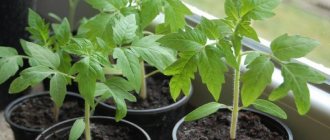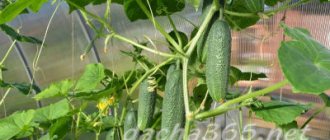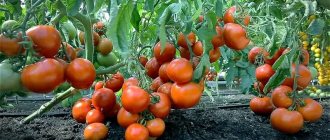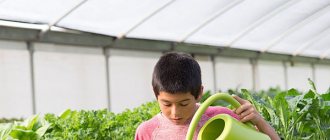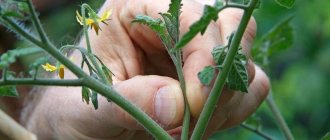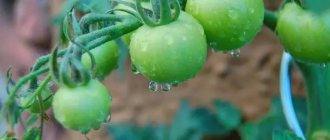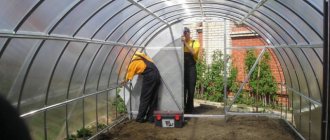The growing season of tomatoes is quite long. In most regions of our country, summer is not very long and there is not enough time for the full cycle of crop ripening. Growing tomatoes in greenhouse conditions provides clear advantages:
- possibility of obtaining an earlier harvest;
- tomatoes produce a larger harvest than those planted in open ground;
- ripening time is reduced.
In order for tomatoes to feel comfortable in a greenhouse, it is necessary to create favorable conditions.
Planting tomato seedlings in a greenhouse
Planting must be done at the right time. This is necessary to obtain strong plants. It is impossible to say the exact time and date, since it depends on the given region and its climatic condition, on the heating of the air at a certain period of the season. You need to prepare a greenhouse, choose the right varieties that need to be planted at one time or another in order to achieve optimal ripening.
Before deciding that the time has come to plant tomato seedlings, you need to carefully examine them. The sprouts should be:
- Straight with strong, green stems.
- The height of one sprout should be no more than 30-35 cm.
- The age of grown seedlings should be no more than 2 months.
- The foliage should be green.
For planting, you need to choose the best seedlings.
Tips and tricks from experienced gardeners
To harvest a bountiful harvest of large fruits in a covering structure, experienced farmers advise:
- Move the seedlings to the greenhouse when the ground warms up well (above +15⁰C).
- Do not overly deepen seedlings when transplanting into a greenhouse (sufficient deepening is 20-25 cm). Greater depth is permissible in relation to overgrown specimens.
- During the period of growth of tomato seedlings in a greenhouse, it is necessary to eliminate diseased and limp leaves located near the ground. It is better to carry out the manipulation in the morning so that the tear area dries out before the evening.
If you strictly adhere to the recommendations for cultivating tomato crops in a greenhouse, you will be able to reap a rich early harvest. Artificial shelter will provide reliable protection for bushes from adverse weather conditions, diseases and pests.
When to do this, optimal timing of transplantation
Proper planting of tomatoes in greenhouses is an important point for a subsequent good harvest. Spring is a good time of year to grow seedlings. It is planted in soil closed from fresh air at the end of April or at the beginning of May. The climate is ideal at this time of year: the frosts have already passed, the weather is warm outside. The soil should be well warmed up by this time.
If the ground temperature at this time is less than +9°, then it is better to wait a few days until the temperature regime is optimal. By this time, tomato sprouts should have at least 8 leaves that are already well developed, and also have about one or more inflorescences. The height should reach 30-35 cm.
Features of preparing a polycarbonate greenhouse
This type of greenhouse is much better than conventional film. It has a long service life. The polycarbonate material is durable and hermetically stable. Allows you to protect crops from drafts and frost. You can plant seedlings in such a greenhouse earlier than in a film analogue. You just need to provide a reliable heating system.
You can plant tomatoes in a polycarbonate greenhouse 15-16 days after they are sown. But before that, you need to prepare the greenhouse itself. First you need to choose a good place for it. Decide where best to put it.
There should be good lighting there. This will ensure plant growth and good yield. It is ideal to place it on a platform illuminated from all sides, without shadow. But if a shadow falls on one side, then additional lighting can be provided. Proper photosynthesis is the key to a good harvest.
The next step is to choose a watering method. It is preferable to install a large tank with warm water in the greenhouse. It is better to choose drip irrigation, but if this is not the case, then you need to consider a different, optimal type.
Ventilation is also an important component of good yield. If it is not possible to install an automatic ventilation system, then you need to systematically open the windows and let in fresh air.
In a greenhouse, it is important to regulate temperature and ventilation.
It often happens that after planting plants in a greenhouse, frost returns. This can have a bad effect on the growth of seedlings. Polycarbonate has good heat-shielding properties, but sometimes they are not enough. To do this, you can insulate the soil if you make a bedding of hay and straw for the seedlings in advance.
How to prepare soil and beds
Before replanting formed sprouts, you need to properly prepare the soil for this. If the greenhouse is located on a foundation, then in any case it will not be possible to move it to another location. Therefore, you need to periodically change the soil, namely: remove the old one, fill in the new one. In this case, the soil should be chosen as a rule after planting legumes, cucumbers, and potatoes.
If you often plant tomatoes in one place, every year, then the soil becomes fully infected with fungal spores and bacteria that harm this vegetable crop. In order to avoid this, you need to treat the soil with a fresh solution of vitriol.
In just three weeks, many experienced gardeners sow green manure seeds on the surface of the ground. After this, you need to dig up the soil well. This will enrich it with the nutrients contained in this component.
Important! If snow fell into the greenhouse during the winter season, this means that the pests in the soil died. They do not tolerate low temperatures.
The beds need to be prepared in advance, 10 days in advance. They need to be placed along the wall, on both sides. If the width of the greenhouse is large, then you can make a third bed in the middle of the greenhouse. The optimal distance between the beds should be about 65 cm, the width of the bed should be up to 85 cm. If you plant seedlings often, then they will interfere with each other and crowd out neighboring sprouts. At the same time, fertility will decrease.
Tomato roots are very sensitive to cold. Therefore, to keep them warm, it is best to raise the beds 40 cm above ground level. But this factor depends on the amount of soil that is available. But even if there are restrictions in this regard, the ground must still be higher than the passages.
Next you need to prepare the holes. The depth should correspond to the developed root system of the stem. The distance between them should be in accordance with the selected tomato variety and type of bush. All wells need to be treated with a light pink potassium permanganate solution. Not only the hole is watered, but also the soil near it. This will help destroy harmful bacteria that destroy the root and thin the stem.
Two days before transplanting tomatoes, you need to thoroughly moisten the soil and loosen it. It is also better to prepare trellises in advance on which you can tie up the grown shoots.
If you decide to arrange warm beds, then planting time is significantly reduced.
What you should know
Before you start growing tomatoes indoors, you should familiarize yourself with:
- rules for preparing a greenhouse structure for the arrangement of tomato beds in it;
- different schemes for planting seedlings in greenhouse soil;
- necessary indoor growing conditions for vegetables;
- a list of varieties bred for growing in covered beds.
How to prepare a greenhouse for tomatoes
By arranging a greenhouse shelter for growing tomatoes correctly, you can create the most suitable conditions for plants to grow and develop. The greenhouse is prepared for the season in advance. It is advisable that the shelter be made of polycarbonate.
In the case of preparing a film structure, you will need to cover the frame with a double layer of polyethylene (nights in May are still too cold for vegetables). The structure will need to be equipped with vents to ensure good ventilation.
Greenhouse soil is also prepared for planting tomato seedlings:
- eliminate last year's layer of turf (about 12 cm);
- disinfect the remaining layer of soil with copper sulfate hydrate (1 tablespoon of substance per 10 liters of water);
- 2 weeks before transferring the seedlings to the shelter, loosen and weed the beds, add humus (from 3 to 8 kg per 1 m²);
- if necessary, enrich the soil with charcoal (consumption - 1 glass per 1 m²);
- On the eve of planting, water the soil with a warm solution of potassium permanganate of low concentration (consumption - 1 liter per 1 hole).
The garden crop feels especially good in loamy or sandy loam, breathable soil. To protect against the cold, plants are planted in high beds (about 40 cm).
Choosing greenhouse varieties: recommendations and tips
When growing greenhouse tomatoes, it is necessary to choose the right variety of vegetable crop. When choosing, take into account the following characteristics:
- yield indicator;
- fruit characteristics (weight, shape, color, taste);
- duration of maturation;
- presence of immunity to diseases;
- bush type;
- Is the variety suitable for the climatic conditions of the growing region?
Tomato varieties for indoor ground are:
| View | Peculiarities |
| Ideterminate (with a tall stem that has no growth boundaries) | Suitable for year-round breeding in a heated shelter. They develop well in polycarbonate and film unheated structures. Good for cultivation in the middle zone and northern regions of the Russian Federation. They produce a lot of fruits from the bush |
| Determinant | Characterized by stems that stop growing after the appearance of the fifth raceme |
| Semi-determinant | The stems do not stop growing after the formation of the fifth cluster, but they also do not stretch upward like indeterminate varieties. The bush is characterized by 2 stems |
Standard varieties of tomatoes are not used for cultivation in greenhouses. They are distinguished by their ability to independently form a bush as they grow. Such plants do not need pinching.
Among the best varieties of tall varieties for growing indoors are:
- De Borao red. The yield indicator is 4 kg per plant. The variety is resistant to late blight. The fruits are characterized by good keeping quality and transportability.
- Ivanhoe F1. The hybrid has strong immunity. Plants are practically not susceptible to disease. The yield is high, the fruits are large (200 g), and grow in clusters.
- Alexy F1. The hybrid is not afraid of mosaic, spotted wilt, or yellow leaf curl. The fruits are large (more than 200 g) and have a bright red color. The hybrid is suitable for year-round cultivation. Grows well in all types of artificial shelters.
What should be the temperature of the earth and air
Tomato seedlings should be planted in a greenhouse when the optimum soil temperature has been reached. If you plant the sprouts in still cold soil, this will not only slow down the growth of the tomato, but can destroy a large number of seedlings.
Even if it seems that the air has warmed up well, this does not mean that the ground also has the desired temperature. In any case, the roots will be much deeper. And this soil cover is always colder than the surface layer. Therefore, you need to take a thermometer and measure the temperature at depth.
You need to check the distance from the surface to a depth of 15 cm. This is the first layer into which the roots of the plant fall. After proper care and good growth, the seedling will take root to a depth of 80 cm. If when measuring the temperature in the region of 10-12 degrees Celsius, then this is a very early period in order to transplant the seedlings into this soil. She will stop growing.
According to experienced gardeners, the optimal temperature for planting tomatoes in a greenhouse is + 13-14 degrees at night and + 15 degrees during the day. This is the optimal temperature to grow good sprouts in an unheated greenhouse.
How to grow seedlings and care for them
Growing tomato seedlings is the main stage in the growth and development of plants. Without healthy bushes you will not get strong and fruit-bearing plants. How to prevent mistakes and get healthy plants and a wonderful harvest? You just need to comply with the necessary conditions:
- Soil preparation. You cannot plant seeds in soil collected anywhere. It is better to use turf soil collected on the site, but not in the greenhouse. It is necessary for the soil to stand in bags over the winter, this will get rid of weeds and pests.
- In January, you can bring the soil indoors, sift it through a large sieve, removing all the debris. The soil should be light and clean. Then you need to water the soil and put it back in the frost. After a few days, bring the soil indoors and let it thaw.
- Soil preparation. You need to mix the soil, peat and humus in a ratio of 1:1:1. Then pour the composition, add a little sand, superphosphate and ash. If purchased soil is used for planting, there is no need to fertilize it.
- It is necessary to disinfect containers for seedlings. The boxes must be more than 7 centimeters in height.
- Fill the containers with soil, water the soil and leave for 10 days.
- Preparing the seeds. Before planting, the seeds need to be kept in a special solution for 20 minutes to stimulate their growth.
- In moist soil, you need to make grooves no more than 1.5 centimeters deep and place the seeds in them at a short distance from each other. Sprinkle them with a little earth and cover with film.
- We place containers with seedlings in a warm place where the air temperature is at least 22 degrees plus.
- After the emergence of seedlings, you need to slightly reduce the ambient temperature, but it should be no less than +18 degrees.
- You need to remember that plants need to breathe, so first you need to remove the film for a while, and then remove it completely.
- You need to water the seedlings with warm water right to the roots.
Picking and hardening of seedlings
Only those plants that are grown in groups in containers need to be picked. If tomatoes grow in large pots, then there is no need to plant them. Picking is necessary so that tomatoes and their roots can develop.
Diving is carried out approximately 2 weeks after emergence, when the young plant has 2 leaves. On the day of diving, there is no need to water the plants; the soil should be light, but slightly moist from the previous watering.
Use a small wooden stick to dig up the plant, then remove it along with the soil and place it in a separate container.
Starting in April, plants can be hardened off. First, you can open the window in the room for a few minutes. Then the ventilation time gradually increases. When the air temperature is +12 degrees, containers with plants can be taken outside. By performing these simple procedures, the plant will get used to natural conditions.
Preparing seedlings for transplantation
You need to start preparing the sprouts 2-3 days in advance. First of all, you need to remove yellow, unhealthy leaves and a few lower ones. At the same time, they must be cut carefully so as not to damage the stem. To do this, you do not need to cut the leaves close to the base of the trunk, but leave small branches.
Without a leaf, they themselves will thin out over time and fall off. At the same time, removing excess foliage will help the rest of the crown and roots receive the nutrients they need for adaptation. The flower branch will develop well.
Before planting tomatoes, you need to moisten them well. This will reduce moisture loss from the roots to a minimum. At the same time, you should also carefully remove the sprouts from the pots, leaving the earth ball around the root system intact.
When planting, seedlings are carefully removed from seedling boxes or cups and, without damaging the roots, planted in the ground.
What to do if it has outgrown
Overgrown seedlings will have a height of more than 40 cm. However, when planting, you should not deepen them into the soil as much as possible. Then the sprout will form additional roots on the sides. This will slow down the development of the peduncle. Flowers will fall off.
To grow good tomatoes, you need to choose the method that will be most effective. You can plant it like this:
- Dig a hole 12-13 cm deep. After that, make another one in it. It should be equal to the height of the pot with seedlings.
- In this case, you need to plant the stem in the lower hole. Do not fill the top one.
- After a few days (usually about 10-12 days), the plant will take root. Then you can fill in the outer hole.
If the tomato sprout has grown greatly and reaches a length of about a meter, then you need to plant it using the following method:
- Three days in advance, trim the lower leaves without damaging the stem.
- Instead of holes, make long furrows. Make holes in each one at equal distances.
- Pour water over everything.
- Seedlings should be planted in them by placing each stem in this furrow. Place the root into the hole.
- To prevent a buried sprout from rising to the surface, it should be strengthened underground with aluminum wire, making arcs out of it.
- Cover with soil and compact.
- Tie the upper part to the picket fence.
The soil that contains overgrown sprouts does not need to be loosened or hilled all summer. If, during watering, the stems dug into the ground become bare, then you need to cover them with soil mixed with peat one to one.
Overgrown seedlings also need to be hardened off before planting.
Preparing the landing site
Tomato seedlings begin to be grown long before planting in the ground. The soil in greenhouses should also be prepared in advance.
Warming up the soil
For the successful growth of heat-loving plants, not only air temperature, but also soil temperature is important . They absolutely cannot be planted in cold soil. In the best case, the seedlings will get sick and do not take root well in the new place; in the worst case, they will simply die. Therefore, before planting tomatoes in the greenhouse, the soil needs to be warmed up. In a heated greenhouse, this is not a problem, as is the case when planting is done at the end of May - June, since by this time the earth warms up on its own. But what if you want to get an early harvest? The instructions below will help you solve this problem:
- Make sure that all the windows in the greenhouse are closed and there are no gaps from torn film or cracked glass anywhere. If necessary, correct any problems.
- Cover the glass or polyethylene greenhouse with an additional layer of transparent film.
- Dig up or loosen the soil inside, then spread black film on top. The soil underneath will warm up faster, since the black color attracts the sun's rays.
Black polyethylene film
- Close the doors tightly.
Of course, you can put a heater inside, but this is done only if you live permanently on the site. After a few days, you can check the soil temperature using a regular household or special thermometer. Planting tomatoes in a greenhouse is allowed at temperatures above +10 degrees. It’s even better to wait until the earth warms up to +15 degrees.
In the photo - a device for measuring temperature and soil moisture
Making beds
The beds in the greenhouse are made about a week before the tomatoes are planted. Their device consists of creating embankments 30-40 cm high from fertile soil mixed with humus. The ridges are made 60-80 cm wide by raking soil from the row spacing. In this case, the width of the passage between the beds must be at least 60 cm. Seedlings will subsequently be planted in one row on each such bed.
Advice. If the greenhouse is small, single-row planting is too wasteful. In such cases, it is better to arrange high beds by making sides from boards with your own hands. Their width should allow plants to be planted in two rows with a distance between them of about half a meter.
Convenient layout for narrow greenhouses - single-row beds along the walls and a double-row in the center
How to properly plant tomatoes in a greenhouse with seedlings, diagram
First of all, planting depends on the height of the tomatoes. When developing a scheme for planting sprouts, you need to consider:
- Will there be stepsoning?
- Attaching the sprout to the picket fence.
- Greenhouse dimensions.
- Irrigation quality.
- Illumination of beds.
Each tomato plant must receive the light and air it needs. Do not crowd in close proximity to other sprouts.
Disembarkation:
- Place a seedling 30 cm long into the hole.
- Sprinkle compost around it.
- Cover with soil and compact.
- Water the planting site.
- Mulch and tie up the sprout.
Arrangement of seedlings in two rows.
Planting pattern, to what depth
One of the possible schemes:
- Make beds at a distance of 55-60 cm between each other.
- Raise the beds to a height of 35 cm.
- Make holes: 25 cm deep, 50 cm between them.
- Water the soil with water and potassium permanganate solution.
- Plant seedlings using the method described above.
Another scheme for planting tomatoes in a greenhouse.
If you properly prepare tomato seedlings, treat them with the right products, ventilate them and make the right beds in the greenhouse, prepare the soil for planting, then this will ensure high yields of tomatoes in the future. In this case, the death of individual shoots can be reduced to a minimum. You can grow good plants that are immune to bacteria and fungi that lead to stem depletion.
